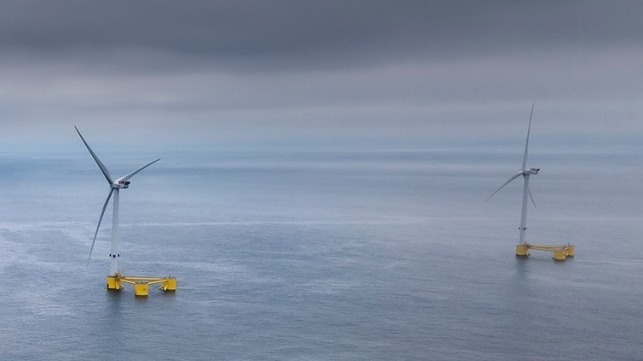Scottish Wind Project Seeks Advantage with Hydrogen Partnership

Interest continues to grow for the potential of combining offshore wind projects with hydrogen to create a green process for the creation of the future fuel. In the latest development, the Salamander floating wind project in development for the northeast coast of Scotland near Aberdeen said it is pursuing the opportunity to become the world’s first combined floating wind and green hydrogen project putting it in competition with similar projects proposed for other areas in Europe.
The 200 MW Salamander floating wind project, developed by the Irish company Simply Blue Energy in partnership with Subsea 7, signed a memorandum of understanding with sustainability consultancy ERM for the potential use of the ERM Dolphyn hydrogen technology. The technology combines electrolysis, desalination, and hydrogen production on a floating wind platform. The hydrogen would be transported to shore through a pipeline. ERM Dolphyn aims to undertake a 10 MW demonstration project, which would produce green hydrogen offshore and provide the first step needed to scale up at Salamander. According to the companies, it is an economic and scalable solution, which produces green hydrogen with no carbon emissions at the point of use.
“When we started the Salamander project, we always envisioned a stepping-stone project and a catalyzer for future, bigger commercial opportunities,” said Adrian de Andres, Salamander Project Director. “Considering the rapidly approaching 2030 deadline for the floating wind and green hydrogen targets, we now think the Salamander project could act not only as a stepping-stone for floating wind but also potentially for green hydrogen production, paving the way for multi-GW green hydrogen developments in the 2030s.”
The Salamander project is targeting a lease under the upcoming Innovation & Decarbonization leasing process and now plans to put forward its ambitious green hydrogen plans to Crown Estate Scotland and Marine Scotland. The hope is that by incorporating hydrogen into their proposal it will provide them an advantage in the upcoming leasing process.
According to the companies, the proximity of the site for the Salamander project to St Fergus Gas Terminal along with the plans for a hydrogen infrastructure in the region around Aberdeenshire and Aberdeen City make their project ideally suited for the combination of offshore wind and hydrogen. They also noted that they are working closely with Scotland Gas Networks (SGN) to potentially integrate with and connect into future hydrogen infrastructure or as a blend with existing gas infrastructure, which SGN is aiming to develop.
The Salamander project they said has been investigating different routes to market since its inception and due to its advantageous location off Aberdeenshire, the project believes producing green hydrogen is a very interesting option.
Scotland has become one of the emerging hotbeds for potential offshore wind projects with both major corporations and emerging companies all seeking to participate in the market. The Scottish government has set a target to reach 11 GW of offshore wind capacity in its waters by 2030. The next round of the leasing project is expected to be announced in early 2022.
